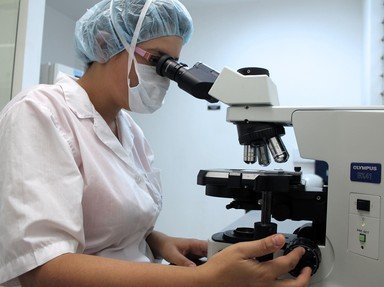Quiz Answer Key and Fun Facts
1. The eukaryotic cell cycle consists of G1, S, G2 and M phases. What vital stage characterises the S phase?
2. G1 and 2 phases are often absent in the first divisions of a fertilised egg cell, but are essential in later cell divisions. What does G stand for in this instance?
3. Once G1, S and G2 phases have taken place, M phase occurs. Mitosis (M phase) is a very busy stage of the cell cycle, and it begins with prophase, which sees the chromosomes condense due to condensin, making them visible under the microscope. What type of molecule is condensin?
4. Bridging the gap between prophase and metaphase is pro-metaphase, during which the nuclear envelope (which holds the chromosomes) breaks down. This is done by adding specific groups to the tyrosine, threonine and serine residues of the envelope's proteins. What is this process called?
5. In pro-metaphase, as well as the breakdown of the nuclear envelope, endocytosis must stop. Which organelle, made up of compartments called cisternae, plays a central role in endocytosis and fragments in this stage of the cell cycle?
6. Another structure which plays a vital role in mitosis begins by being duplicated in the S phase. These duplicated structures then move apart from one another and nucleate the microtubules which form the spindle. What is the name of these structures?
7. Microtubules are the structures which form the spindle apparatus. The spindle attaches to chromosomes and aids the separation of the sister chromatids during anaphase. Which of the following is not one of the three types of microtubule which form the spindle?
8. Before sister chromatids can be separated, spindle fibres must attach to a special structure on the centromere (the structure which holds the chromatids together). What name is given to this special structure, which assembles on the centromere in late prophase?
9. Once both sister chromatids have established connections with microtubules, they experience tension and line up along the middle of the cell. This stage is known as metaphase. Which of the following is a term used to describe the mid-line of the cell?
10. Eg5 is a protein essential for establishing microtubule stability and moving the chromatids apart in anaphase. Knowing that it moves cargo towards the + end of the microtubules, what type of protein can Eg5 be described as being?
11. Proteins known as cohesins hold sister chromatids together prior to anaphase, where they are broken down by enzymes, allowing each sister to move to opposite poles to the cell. What is the rather unimaginative name of the enzyme which cleaves cohesin?
12. In order for the microtubules to pull sister chromatids to opposites poles of the cell, they must be destabilised. What term is given to the constant polymerisation and depolymerisation of microtubules during mitosis?
13. Once the sister chromatids have been moved apart in anaphase, the nuclear envelope reforms around each set of chromosomes (this stage is known as telophase). What type of structures are lamins, a major constituent of the nuclear envelope?
14. Once telophase has taken place, cytokinesis (cell splitting) must occur. This is aided by a contractile ring which forms in the middle of the cell. Which protein, more usually associated with muscles, plays a key role in cytokinesis?
15. The typical image of a cell is one which is round. However, most cells are only round during cell division, as their connections to surrounding matrices are phosphorylated (and broken). Which protein, which connects cells to surrounding collagen fibres, is phosphorylated during cell division, making cells appear round?
Source: Author
doublemm
This quiz was reviewed by FunTrivia editor
crisw before going online.
Any errors found in FunTrivia content are routinely corrected through our feedback system.

